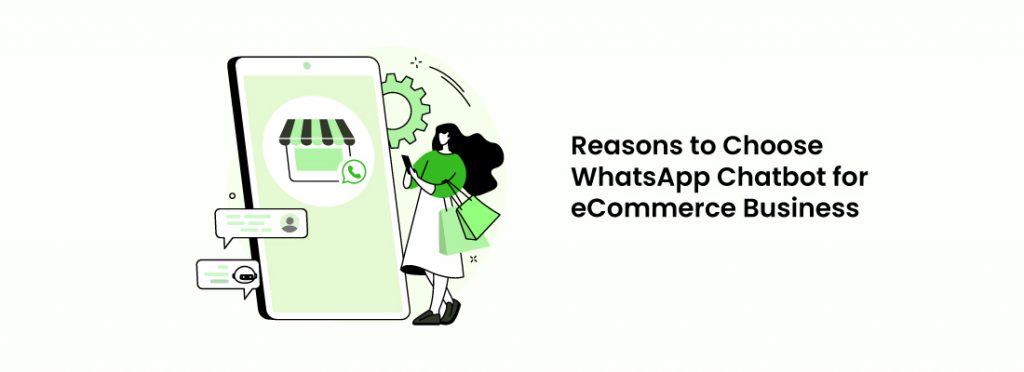WhatsApp Chatbot For eCommerce: Chatbots have been successfully controlling the diverse kingdom of eCommerce for a few years now.
More and more, customers grow as usual to the concept. 60% of respondents claim to use a bot to talk to a business in the past 12 months!
However, today communication way is shifting from chatbots to messaging apps such as WhatsApp. Even everybody wonders what the potential of WhatsApp eCommerce integration with the release of WhatsApp API is.
Consumers use WhatsApp bots to resolve issues, get quick answers in emergencies, and have 24-hour service.
They associate messaging with comfort and convenience. No need to mention, offering a customized experience can be challenging, and using technology like a WhatsApp chatbot can be helpful.
Benefits of having a WhatsApp chatbot for eCommerce business
Turning shoppers into paying customers and making profits are the biggest challenges that face the eCommerce sector nowadays.
A WhatsApp chatbot for eCommerce automates resolving customer queries and decreases overhead and improves customer support team efficiency.
Here are some benefits of using WhatsApp chatbot for eCommerce:
- It lets for real-time conversations with quick answers to customers’ queries
- It enables companies to assist customers on their preferred chat platform and increase their shopping experience
- It helps customers to take immediate actions and build trust with customers
- It enables secure customer communications with end-to-end encryption on WhatsApp
Let’s explore its use cases and why you should use this bot for your eCommerce sector.
Top 5 WhatsApp chatbot use cases for e-commerce
There are countless chatbot use cases in several sectors. But, in this blog, we will describe helpful use cases for WhatsApp that drive customer acquisition, and retention and improve experience and loyalty.
Let’s take a look at eight use cases of WhatsApp chatbot for eCommerce.
Use cases #1 – Lead Generation
WhatsApp chatbot for eCommerce lets you automate this process entirely. It gets customers to give their details via a simple click-to-chat link.
After starting a conversation by sending you a message, you automatically get their name and phone number.
At this point, you have a great chance to contain a powerful CTA in either of the following ways-
Product/Category button
You can use this to allow your potential customers to get notifications or updates through WhatsApp. For example – customers can sign up to get a notification when they want to buy in stock.
Chat invite
Using the WhatsApp chatbot, you can proactively invite your website visitors to have a conversation and get their queries resolved using WhatsApp.
Campaign Ads
Another perfect way to get new customers is to use the click-to-WhatsApp approach in all your paid campaigns. Hence, when potential clients click on your Facebook or Google ad, they will be directed to a WhatsApp chat invitation for better engagement.
Use case #2 – Increase sales
WhatsApp chatbot helps engage with new customers and customize the overall sales. You can engage with users familiar by offering discounts on the products.
It will generate interest in the mind of your customers and continue to complete the purchase process.
Use case #3 – Information gathering
If a user gets in contact with your WhatsApp chatbot, you will automatically collect their contact number and name.
Limited with the given information when you have a great way to get more customers’ details.
In getting the conversation with the customers, you can get better details to make the overall experience customized for them based on their interests, language, and region.
It helps in separating a list of customers with similar product interests to similar product interests to send broadcast messages simultaneously, which can get better attention from interested customers.
Use case #4 – Product Guides
Customers can get better details about a product before they are planning to purchase it.
The provided details below the product description may confuse the customers and expecting an immediate response from customer service is reasonably not possible.
That’s where chatbots come in and have become a vital part of the eCommerce industry.
They can handle inquiries significantly faster and more efficiently so, reducing the wait.
WhatsApp chatbots perform as a better product guide to reply in detail about the products at a fast pace.
Use case #5 – Refund or Replacement Scheduling
Managing refunds and replacements is one of the most tricky features of eCommerce customer flow. If it is not handled smoothly, a bad refund experience can result in dissatisfied customers.
On the contrary side, a hassle-free and quick refund experience can be enriching in the form of improved retention rates and long-term customer loyalty.
WhatsApp chatbot in eCommerce can offer a great refund/replacement user experience due to their quick and easy process.
WhatsApp chatbot helps to easily identify the reason for getting a quick refund.
So, these are some use cases of why WhatsApp chatbot is suitable for your eCommerce business.
If you want any WhatsApp chatbot for your eCommerce industry, you need to get in touch with Yugasa Bot!
How can Yugasa Bot help in WhatsApp chatbot development for eCommerce?
If you are looking for a reliable and innovative WhatsApp chatbot solution for your eCommerce business, Yugasa Bot is the right place!
We have many years of experience in delivering successful WhatsApp chatbot solutions for different industries.
When you get in touch with us, our dedicated team of experts uses advanced features and the latest technologies to deliver your desired bot solution.
For more information on the WhatsApp chatbot for eCommerce, contact our experts today!
Read More: How To Integrate The Chatbot With Email Marketing?







